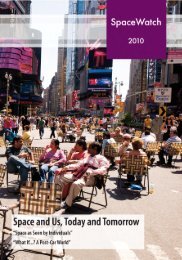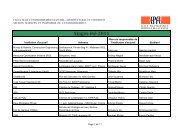laba manifest - ENAC | School of Architecture, Civil and ...
laba manifest - ENAC | School of Architecture, Civil and ...
laba manifest - ENAC | School of Architecture, Civil and ...
You also want an ePaper? Increase the reach of your titles
YUMPU automatically turns print PDFs into web optimized ePapers that Google loves.
ocess is complex <strong>and</strong> requires large quantities <strong>of</strong> data <strong>and</strong> significant<br />
rn a valid topography. This process is, itself, not a design methodology,<br />
o drive context or data for generative design methods. However, if the<br />
is an abstract or re-interpreted surface (rather than 1:1 precision) then<br />
ay be computationally inefficient <strong>and</strong> overly complex for the desired<br />
rams<br />
on is a decompositional method for subdividing an area or volume.<br />
determined by an explicit Research<br />
distribution <strong>of</strong> points, where each point<br />
oid <strong>of</strong> a corresponding Voronoi cell. The shape <strong>and</strong> area <strong>of</strong> each cell are<br />
hat the boundary is a function <strong>of</strong> the distance to all immediately<br />
that field. The simplicity <strong>of</strong> the diagram <strong>and</strong> mathematics allows it to<br />
lar but associative division, but the method can be used in three (<strong>and</strong><br />
r) dimensions.<br />
i Diagrams: a.) 2-D diagram, b.) 3-D conceptual model (Knauss + Oesterle)<br />
med after Georgy Voronoi, who developed the mathematical method<br />
cell distribution <strong>and</strong> from mathematical packing theory. The<br />
hod is used extensively in disciplines involved in mapping <strong>and</strong> statistics,<br />
in fields <strong>of</strong> biology, chemistry <strong>and</strong> metallurgy. This method has been<br />
ed in digital art <strong>and</strong> architecture investigations. 15 Its popularity has<br />
oint where some s<strong>of</strong>tware programs have recently encoded Voronoi<br />
e general toolsets, <strong>and</strong> in others CAD s<strong>of</strong>tware external plug-in’s are<br />
te the subdivisions. xv<br />
mars<br />
are a conceptual system used for investigation <strong>of</strong> emergent systems in<br />
d conceives a design as an experimental test field, which is populated by<br />
with specific behavioural rules <strong>and</strong> interactive potential. The system is<br />
hrough iteration, <strong>and</strong> the resulting behaviours <strong>and</strong> interactions reveal<br />
the system. Conceptually the system determines the complex<br />
otential <strong>of</strong> an emergent system<br />
re inherently graphical languages, <strong>and</strong> as such they require a medium<br />
he generation engine for interaction. Shape grammars differ from<br />
es <strong>and</strong> Chomsky dictum in that the development <strong>of</strong> a system may occur<br />
. (2010):15<br />
digital technologies application<br />
fish farming in Mediterranean sea<br />
GIS visualisation<br />
Bifurcation <strong>of</strong> the Digital Chain<br />
This research investigates contemporary digital technologies <strong>and</strong> how they<br />
are influencing architectural design <strong>and</strong> production.<br />
The parameters affecting architectural design are becoming increasingly<br />
complex <strong>and</strong> interrelated. In contemporary society, digital tools are used to<br />
mange the complexity <strong>of</strong> information, <strong>and</strong> digital technologies have changed<br />
the way people interact with information <strong>and</strong> the world around them. This<br />
thesis investigates the use <strong>of</strong> contemporary digital technologies in design <strong>and</strong><br />
production to determine if they are also being used effectively to manage the<br />
increasing complexity <strong>of</strong> architectural design projects. The research explores<br />
this topic at the level <strong>of</strong> both design theory <strong>and</strong> technology theory, <strong>and</strong> then<br />
employs practical design <strong>and</strong> production investigations as “pro<strong>of</strong> <strong>of</strong> concept”<br />
for the developed theories. The research work concludes by providing an<br />
answer to the question: “do current digital technologies constitute a paradigmshift<br />
in architecture?”.<br />
The role <strong>of</strong> ocean space in contemporary urbanization<br />
Pressure on ocean space for energy production, extraction <strong>of</strong> resources,<br />
residential, infrastructural <strong>and</strong> logistical development is increasing. Although<br />
research has shown that almost no part <strong>of</strong> the global ocean remains<br />
unaffected by human impact, as yet few architects are involved in this process<br />
<strong>and</strong> physical structures in the ocean seem to be determined by engineering<br />
<strong>and</strong> world market logistics.<br />
The objective <strong>of</strong> this research is to propose a position for ocean spatial typologies<br />
within the contemporary urban debate in relation to networks, l<strong>and</strong>scape,<br />
ecology <strong>and</strong> technology. Ocean activities characterized by a quantum shift in<br />
intensity, scale <strong>and</strong> technology will be the focus <strong>of</strong> the examination.<br />
Preliminary investigations have revealed that the majority <strong>of</strong> spatial decisions<br />
about the ocean apply planning instruments directly comparable to those<br />
used on l<strong>and</strong>.<br />
Interaction with water in the form <strong>of</strong> planning implies particular operational<br />
conditions <strong>and</strong> responsible treatment <strong>of</strong> a valuable resource <strong>and</strong> a complex<br />
habitat. Which forms <strong>of</strong> urbanisation, <strong>and</strong> which planning strategies can be<br />
developed with the ocean itself as an “active” agent?<br />
GeoDesign as an approach to <strong>Architecture</strong><br />
In architecture a variety <strong>of</strong> 2D <strong>and</strong> 3D CAD s<strong>of</strong>tware solutions are used for<br />
design <strong>and</strong> design rendering to create a virtual representation <strong>of</strong> architectural<br />
projects. Although these tools have a great capacity <strong>of</strong> h<strong>and</strong>ling large amounts<br />
<strong>of</strong> data, they fail in integrating the project in it’s urban <strong>and</strong> environmental<br />
context. Geographic Information Systems <strong>and</strong> their s<strong>of</strong>tware application can<br />
<strong>of</strong>fer the missing support in designing a well-integrated project.<br />
Laba thus investigates the possibility <strong>of</strong> creating a GIS Decision Making<br />
S<strong>of</strong>tware Model for <strong>Architecture</strong>, both using existing s<strong>of</strong>tware <strong>and</strong> new<br />
s<strong>of</strong>tware development. <strong>laba</strong>’s existing <strong>and</strong> extensive methodology <strong>of</strong> site<br />
investigation will be exp<strong>and</strong>ed through a GIS DMM (Decision Making Model).<br />
This model will incorporate a multitude <strong>of</strong> data layers, from climate data up to<br />
political administration information, which will enable the designer to grasp<br />
the local situation in one central location.<br />
<strong>laba</strong> <strong>manifest</strong> - june 2012 11





